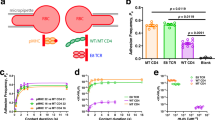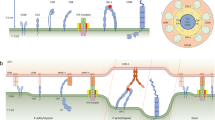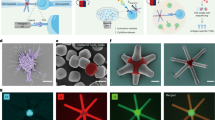Abstract
The T-cell receptor (TCR) interacts with peptide-major histocompatibility complexes (pMHC) to discriminate pathogens from self-antigens and trigger adaptive immune responses. Direct physical contact is required between the T cell and the antigen-presenting cell for cross-junctional binding where the TCR and pMHC are anchored on two-dimensional (2D) membranes of the apposing cells1. Despite their 2D nature, TCR–pMHC binding kinetics have only been analysed three-dimensionally (3D) with a varying degree of correlation with the T-cell responsiveness2,3,4. Here we use two mechanical assays5,6 to show high 2D affinities between a TCR and its antigenic pMHC driven by rapid on-rates. Compared to their 3D counterparts, 2D affinities and on-rates of the TCR for a panel of pMHC ligands possess far broader dynamic ranges that match that of their corresponding T-cell responses. The best 3D predictor of response is the off-rate, with agonist pMHC dissociating the slowest2,3,4. In contrast, 2D off-rates are up to 8,300-fold faster, with the agonist pMHC dissociating the fastest. Our 2D data suggest rapid antigen sampling by T cells and serial engagement of a few agonist pMHCs by TCRs in a large self pMHC background. Thus, the cellular environment amplifies the intrinsic TCR–pMHC binding to generate broad affinities and rapid kinetics that determine T-cell responsiveness.
This is a preview of subscription content, access via your institution
Access options
Subscribe to this journal
Receive 51 print issues and online access
$199.00 per year
only $3.90 per issue
Buy this article
- Purchase on Springer Link
- Instant access to full article PDF
Prices may be subject to local taxes which are calculated during checkout




Similar content being viewed by others
Change history
12 April 2010
In the online–only Methods, Pa was changed to Passoc in three places on 12 April 2010. Please see the erratum at the end of the PDF for details.
References
Dustin, M. L., Bromley, S. K., Davis, M. M. & Zhu, C. Identification of self through two-dimensional chemistry and synapses. Annu. Rev. Cell Dev. Biol. 17, 133–157 (2001)
Davis, M. M. et al. Ligand recognition by αβ T cell receptors. Annu. Rev. Immunol. 16, 523–544 (1998)
Gascoigne, N. R., Zal, T. & Alam, S. M. T-cell receptor binding kinetics in T-cell development and activation. Expert Rev. Mol. Med. 2001, 1–17 (2001)
Stone, J. D., Chervin, A. S. & Kranz, D. M. T-cell receptor binding affinities and kinetics: impact on T-cell activity and specificity. Immunology 126, 165–176 (2009)
Chesla, S. E., Selvaraj, P. & Zhu, C. Measuring two-dimensional receptor-ligand binding kinetics by micropipette. Biophys. J. 75, 1553–1572 (1998)
Chen, W., Evans, E. A., McEver, R. P. & Zhu, C. Monitoring receptor-ligand interactions between surfaces by thermal fluctuations. Biophys. J. 94, 694–701 (2008)
Huang, J., Edwards, L. J., Evavold, B. D. & Zhu, C. Kinetics of MHC-CD8 interaction at the T cell membrane. J. Immunol. 179, 7653–7662 (2007)
Chen, W., Zarnitsyna, V. I., Sarangapani, K. K., Huang, J. & Zhu, C. Measuring receptor-ligand binding kinetics on cell surfaces: from adhesion frequency to thermal fluctuation methods. Cell. Mol. Bioeng. 1, 276–288 (2008)
Zarnitsyna, V. I. et al. Memory in receptor-ligand-mediated cell adhesion. Proc. Natl Acad. Sci. USA 104, 18037–18042 (2007)
Howarth, M. et al. A monovalent streptavidin with a single femtomolar biotin binding site. Nature Methods 3, 267–273 (2006)
Alam, S. M. et al. Qualitative and quantitative differences in T cell receptor binding of agonist and antagonist ligands. Immunity 10, 227–237 (1999)
Rosette, C. et al. The impact of duration versus extent of TCR occupancy on T cell activation: a revision of the kinetic proofreading model. Immunity 15, 59–70 (2001)
Zhang, F. et al. Two-dimensional kinetics regulation of αLβ2-ICAM-1 interaction by conformational changes of the αL-inserted domain. J. Biol. Chem. 280, 42207–42218 (2005)
Huang, J. et al. Quantifying the effects of molecular orientation and length on two-dimensional receptor-ligand binding kinetics. J. Biol. Chem. 279, 44915–44923 (2004)
Mehta, P., Cummings, R. D. & McEver, R. P. Affinity and kinetic analysis of P-selectin binding to P-selectin glycoprotein ligand-1. J. Biol. Chem. 273, 32506–32513 (1998)
Wu, L. C., Tuot, D. S., Lyons, D. S., Garcia, K. C. & Davis, M. M. Two-step binding mechanism for T-cell receptor recognition of peptide MHC. Nature 418, 552–556 (2002)
Nicholson, M. W., Barclay, A. N., Singer, M. S., Rosen, S. D. & van der Merwe, P. A. Affinity and kinetic analysis of L-selectin (CD62L) binding to glycosylation-dependent cell-adhesion molecule-1. J. Biol. Chem. 273, 763–770 (1998)
Zehn, D., Lee, S. Y. & Bevan, M. J. Complete but curtailed T-cell response to very low-affinity antigen. Nature 458, 211–214 (2009)
Schamel, W. W. et al. Coexistence of multivalent and monovalent TCRs explains high sensitivity and wide range of response. J. Exp. Med. 202, 493–503 (2005)
Lillemeier, B. F. et al. TCR and Lat are expressed on separate protein islands on T cell membranes and concatenate during activation. Nature Immunol. 11, 90–96 (2009)
Campi, G., Varma, R. & Dustin, M. L. Actin and agonist MHC-peptide complex-dependent T cell receptor microclusters as scaffolds for signaling. J. Exp. Med. 202, 1031–1036 (2005)
Yokosuka, T. et al. Newly generated T cell receptor microclusters initiate and sustain T cell activation by recruitment of Zap70 and SLP-76. Nature Immunol. 6, 1253–1262 (2005)
Zidovetzki, R. & Levitan, I. Use of cyclodextrins to manipulate plasma membrane cholesterol content: evidence, misconceptions and control strategies. Biochim. Biophys. Acta 1768, 1311–1324 (2007)
Aleksic, M. O. et al. Dependence of T cell antigen recognition on T cell receptor-peptide MHC confinement time. Immunity 32, 163–174 (2010)
Davis, S. J. & van der Merwe, P. A. The kinetic-segregation model: TCR triggering and beyond. Nature Immunol. 7, 803–809 (2006)
McKeithan, T. W. Kinetic proofreading in T-cell receptor signal transduction. Proc. Natl Acad. Sci. USA 92, 5042–5046 (1995)
Valitutti, S., Muller, S., Cella, M., Padovan, E. & Lanzavecchia, A. Serial triggering of many T-cell receptors by a few peptide-MHC complexes. Nature 375, 148–151 (1995)
Daniels, M. A. et al. Thymic selection threshold defined by compartmentalization of Ras/MAPK signalling. Nature 444, 724–729 (2006)
Davis, M. M. et al. T cells as a self-referential, sensory organ. Annu. Rev. Immunol. 25, 681–695 (2007)
Henrickson, S. E. et al. T cell sensing of antigen dose governs interactive behavior with dendritic cells and sets a threshold for T cell activation. Nature Immunol. 9, 282–291 (2008)
Sabatino, J. J., Shires, J., Altman, J. D., Ford, M. L. & Evavold, B. D. Loss of IFN-γ enables the expansion of autoreactive CD4+ T cells to induce experimental autoimmune encephalomyelitis by a nonencephalitogenic myelin variant antigen. J. Immunol. 180, 4451–4457 (2008)
Evans, E., Leung, A., Heinrich, V. & Zhu, C. Mechanical switching and coupling between two dissociation pathways in a P-selectin adhesion bond. Proc. Natl Acad. Sci. USA 101, 11281–11286 (2004)
Hochmuth, R. M. in Handbook of Bioengineering (eds Skalak, R. & Chien, S.) (McGraw-Hill, 1987)
Lou, J. et al. Flow-enhanced adhesion regulated by a selectin interdomain hinge. J. Cell Biol. 174, 1107–1117 (2006)
Zhu, C., Long, M. & Bongrand, P. Measuring receptor/ligand interaction at the single bond level: experimental and interpretive issues. Ann. Biomed. Eng. 30, 305–314 (2002)
Williams, T. E., Selvaraj, P. & Zhu, C. Concurrent binding to multiple ligands: kinetic rates of CD16b for membrane-bound IgG1 and IgG2. Biophys. J. 79, 1858–1866 (2000)
Williams, T. E., Nagarajan, S., Selvaraj, P. & Zhu, C. Quantifying the impact of membrane microtopology on effective two-dimensional affinity. J. Biol. Chem. 276, 13283–13288 (2001)
Wu, L. et al. Impact of carrier stiffness and microtopology on two-dimensional kinetics of P-selectin and P-selectin glycoprotein ligand-1 (PSGL-1) interactions. J. Biol. Chem. 282, 9846–9854 (2007)
Evans, E., Heinrich, V., Leung, A. & Kinoshita, K. Nano- to microscale dynamics of P-selectin detachment from leukocyte interfaces. I. Membrane separation from the cytoskeleton. Biophys. J. 88, 2288–2298 (2005)
Acknowledgements
We thank the NIH Tetramer Core Facility at Emory University for providing MHC monomers, J. Altman for providing the H-2Kb mutant construct, G. Bao for providing the divalent streptavidin, as well as M. Davis and H.-T. He for commenting on the manuscript. This work was supported by NIH grants AI38282 and AI060799 (to C.Z.) and NS062358, and National Multiple Sclerosis Society Grant RG4047-A-3 (to B.D.E.).
Author Contributions N.J. and C.Z. initiated the research with F5 T cells; J.H. and C.Z. designed the kinetic study; J.H. and B.L. performed the micropipette experiments; V.I.Z. performed the BFP experiments and Monte Carlo simulations; L.J.E. and B.D.E. provided the T cells and conducted the functional study; J.H., V.I.Z., B.L. and C.Z. analysed the data; B.D.E. and C.Z. wrote the paper with all authors contributing.
Author information
Authors and Affiliations
Corresponding authors
Ethics declarations
Competing interests
The authors declare no competing financial interests.
Supplementary information
Supplementary Information
This file contains Supplementary Figures 1-12 with legends and Supplementary Movie legends. (PDF 1058 kb)
Supplementary Movie 1
In this movie we see micropipette adhesion frequency assay (see Supplementary Information file for full legend). (MOV 3871 kb)
Supplementary Movie 2
In this movie we see BFP adhesion frequency assay (see Supplementary Information file for full legend). (MOV 4566 kb)
Supplementary Movie 3
In this movie we see BFP thermal fluctuation assay (see Supplementary Information file for full legend). (MOV 267 kb)
Rights and permissions
About this article
Cite this article
Huang, J., Zarnitsyna, V., Liu, B. et al. The kinetics of two-dimensional TCR and pMHC interactions determine T-cell responsiveness. Nature 464, 932–936 (2010). https://doi.org/10.1038/nature08944
Received:
Accepted:
Published:
Issue Date:
DOI: https://doi.org/10.1038/nature08944
This article is cited by
-
Multimodal probing of T-cell recognition with hexapod heterostructures
Nature Methods (2024)
-
PIEZO1 mechanically regulates the antitumour cytotoxicity of T lymphocytes
Nature Biomedical Engineering (2024)
-
T cell receptor therapeutics: immunological targeting of the intracellular cancer proteome
Nature Reviews Drug Discovery (2023)
-
Catch bond models may explain how force amplifies TCR signaling and antigen discrimination
Nature Communications (2023)
-
Discrimination between cyclic nucleotides in a cyclic nucleotide-gated ion channel
Nature Structural & Molecular Biology (2023)
Comments
By submitting a comment you agree to abide by our Terms and Community Guidelines. If you find something abusive or that does not comply with our terms or guidelines please flag it as inappropriate.



